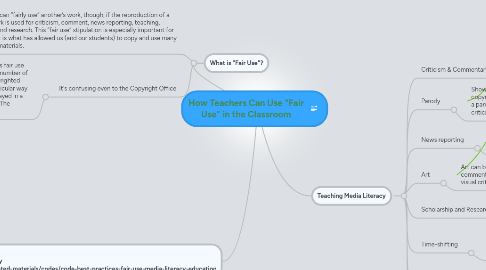
1. What is "Fair Use"?
1.1. An individual can “fairly use” another’s work, though, if the reproduction of a particular work is used for criticism, comment, news reporting, teaching, scholarship, and research. This “fair use” stipulation is especially important for teachers, as it is what has allowed us (and our students) to copy and use many copyrighted materials.
1.2. It's confusing even to the Copyright Office
1.2.1. Even the U.S. Patent Office states on the Copyright Fair Use website that “The distinction between what is fair use and what is infringement in a particular case will not always be clear or easily defined. There is no specific number of words, lines, or notes that may safely be taken without permission. Acknowledging the source of the copyrighted material does not substitute for obtaining permission.” The office also states, “Copyright protects the particular way authors have expressed themselves. It does not extend to any ideas, systems, or factual information conveyed in a work. The safest course is to get permission from the copyright owner before using copyrighted material. The Copyright Office cannot give this permission.”
2. Teaching Media Literacy
2.1. Criticism & Commentary
2.2. Parody
2.2.1. Shows like the Simpsons or Family Guy can make references to copyrighted materials because they are often doing it in the form of a parody. Parodies are often looked at in writing as a type of criticism or commentary and fall under the argumentative writing.
2.3. News reporting
2.3.1. Newspapers are allowed to quote small portions of copyrighted text in order to make a point for commentary or to educate readers.
2.4. Art
2.4.1. Art can be used in other artwork or alone if it comments on culture; it then becomes a form of visual criticism and commentary.
2.5. Scholarship and Research
2.5.1. If you are educating and informing the public about copyrighted content, it falls under "fair use".
2.6. Time-shifting
2.6.1. It is OK to record anything on TV to watch and view later. This means we are allowed to use DVRs, VCRs, etc.
2.6.1.1. This means you can record a show and then use it in the classroom with a lesson.
2.7. Search Engines
2.7.1. When search engines like Google use thumbnails of copyrighted images in a search, it's "fair use" because it helps the users find what they are looking for.
